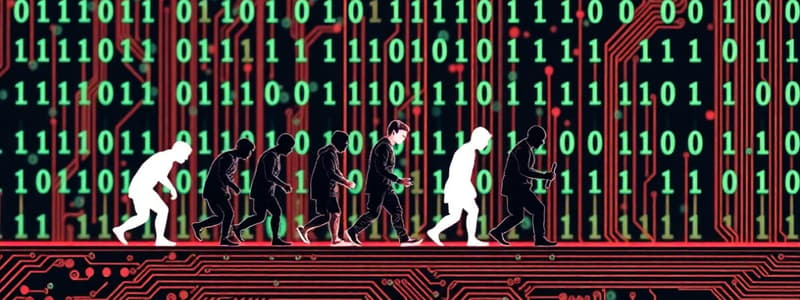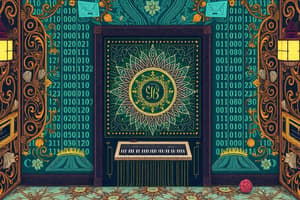Podcast
Questions and Answers
What are some examples of operating systems employed in smartphones?
What are some examples of operating systems employed in smartphones?
- BSD and Solaris
- Windows, Android, and iPhone (correct)
- DOS and Ubuntu
- Linux and UNIX
UNIX OS is known for its instability and is not widely used on the Internet.
UNIX OS is known for its instability and is not widely used on the Internet.
False (B)
Name one type of malevolent application software.
Name one type of malevolent application software.
virus
The __________ protocol is used by ISPs to connect computers to the Internet.
The __________ protocol is used by ISPs to connect computers to the Internet.
Match the following application software with their functions:
Match the following application software with their functions:
Which of the following serves as the primary processing unit in a computer?
Which of the following serves as the primary processing unit in a computer?
The CPU is embedded in the motherboard.
The CPU is embedded in the motherboard.
What coding language is primarily used to encode data in computers?
What coding language is primarily used to encode data in computers?
Computer hardware includes the physical components, while _____ provides the programs to process data.
Computer hardware includes the physical components, while _____ provides the programs to process data.
What technology development allowed users to input data through a graphical interface?
What technology development allowed users to input data through a graphical interface?
Match the following components with their correct descriptions:
Match the following components with their correct descriptions:
Peripheral devices are internal components of the computer.
Peripheral devices are internal components of the computer.
Name one type of data source that the CPU can connect to.
Name one type of data source that the CPU can connect to.
Which of the following devices is NOT typically used to submit data for processing?
Which of the following devices is NOT typically used to submit data for processing?
RAM chips are used for storing permanent data.
RAM chips are used for storing permanent data.
What is the purpose of a boot sequence in a computer?
What is the purpose of a boot sequence in a computer?
A __________ is typically used for storing large amounts of data in a computer.
A __________ is typically used for storing large amounts of data in a computer.
Which feature of Microsoft Windows OS was an improvement over DOS?
Which feature of Microsoft Windows OS was an improvement over DOS?
Match the storage types to their descriptions:
Match the storage types to their descriptions:
Apple's OS is known for its command-line interface.
Apple's OS is known for its command-line interface.
Name one common input device used for data submission.
Name one common input device used for data submission.
What is the primary function of a router?
What is the primary function of a router?
Cookies are used to send large amounts of data between computers.
Cookies are used to send large amounts of data between computers.
What do higher-speed Internet connections typically measure speed in?
What do higher-speed Internet connections typically measure speed in?
What distinguishes cloud computing from traditional software?
What distinguishes cloud computing from traditional software?
Electronic bulletin boards do not require a manager to manage the posts.
Electronic bulletin boards do not require a manager to manage the posts.
What does URL stand for in Internet communications?
What does URL stand for in Internet communications?
A _____ is a unit of data exchanged among computers.
A _____ is a unit of data exchanged among computers.
Match the following network terms with their descriptions:
Match the following network terms with their descriptions:
Internet Relay Chat (IRC) typically involves ______ for real-time exchanges.
Internet Relay Chat (IRC) typically involves ______ for real-time exchanges.
Match the forms of digital communication with their characteristics:
Match the forms of digital communication with their characteristics:
Which of the following best describes a hub?
Which of the following best describes a hub?
All domain names must end in .com.
All domain names must end in .com.
What is the main difference between an intranet and an internet?
What is the main difference between an intranet and an internet?
Flashcards are hidden until you start studying
Study Notes
A Brief History of Computers
- Calculating machines are predecessors to computers, dating back centuries.
- Encoding data in binary language is ideal for computers.
- Computers have evolved from vacuum tubes to solid state processors.
- Data input has evolved from paper tape to graphical user interfaces (GUIs).
Computer Language
- Computer hardware includes the physical device, while software provides the program that processes data.
- Programs are written in binary language.
Computer Hardware
- The central processing unit (CPU) is comprised of millions of transistors.
- Transistors use electricity to represent values of 1 or 0.
- The CPU is an integrated circuit embedded on a circuit board called the motherboard.
- The CPU connects to essential computer hardware including:
- PC cards, used primarily with laptops
- Wires that connect to memory chips, buses, peripheral devices, universal serial buses (USBs), and other sources of data.
- Input devices include:
- Keyboards
- Modems, which connect to a network
- Scanners, which convert printed information to digital format
- Memory storage includes:
- ROM chips, for permanent data
- RAM chips, for temporary storage
- Mass storage devices include:
- Hard drives, which store large quantities of data
- Flash or thumb drives, which connect to a computer via USB
Computer Software
- Boot sequence instructions guide the computer at startup.
- The operating system (OS) runs applications, provides a graphical user interface, and allows users to interact with the computer.
- Examples of applications include office productivity software such as Microsoft Office Suite.
Beyond DOS: Contemporary Operating Systems
- Microsoft Windows improved upon DOS by:
- Adding a graphical user interface (GUI) and features like Plug and Play.
- Creating a central registry.
- Upgrading to 32-bit and 64-bit computing.
- Apple's OS leveraged its Macintosh hardware's "point and click" usability.
- Upgrades have expanded capacity of Apple's computers, including advanced graphics and file storage within folders.
- Newer versions of OSs use UNIX as a foundation.
- UNIX OS includes a kernel, shell, tools, and applications.
- It's known for its stability and is the backbone of the internet.
- Free, open-source versions include LINUX and Android.
- Smartphones use various operating systems, including Windows, Android, and iPhone OS.
Application Software
- Application software (e.g., Internet Explorer or Safari) utilizes the underlying capacity of an OS.
- Malware, such as viruses, Trojan horses, and worms, can exploit OS vulnerabilities.
- Anti-virus software and firewalls can mitigate malware attacks.
- Newer forms of malware, like droppers and logic bombs, continue to pose threats.
A Brief History of the Internet
- The internet originated as a communication network.
- Its widespread use increased with the development of graphical interfaces like web browsers.
- Internet service providers (ISPs) connect computers to the internet.
- The hypertext transfer protocol (HTTP) governs how data is linked between domains and locations.
Network Language
- Key network technology terms include:
- Routers - connect networks together
- Hubs - amplify and transmit communication signals
- Packets - units of exchanged data that allow for multiple transmissions on a data line
- Cookies - small data pieces sent by a server to a browser, often storing user preferences
- Domain name system - a network of computers sharing a common Internet Protocol (IP) address, using extensions like .com, .net, or .org.
- Peer-to-peer (P2P) networking - connects computers directly, where one acts as a client and the other as a server, potentially allowing for user anonymity
- Cloud computing - provides computing services through a system of servers used for data and software storage over the internet.
Realms of the Cyberworld
- Networked systems include:
- Intranets - local networks, often limited to a single organization
- Internets - larger than intranets, typically consisting of several networks
- The Internet - a global network
Data Bandwidth Transfer Rates
- Dial-up connections measure data transfer speed in terms of bands.
- Higher-speed connections, such as cable, satellite, digital subscriber lines (DSLs), or dedicated lines, typically utilize megabits per second (Mbps) as a measurement.
Categorizing Internet Communications
- The World Wide Web (www) connects Internet sites, often for commercial purposes.
- Each site has a Uniform Resource Locator (URL) and an associated domain name.
- Older forms of digital communication provided less efficient and more complex methods of connection.
- Electronic bulletin boards (BBs) - use a manager to moderate posts, providing greater anonymity for users.
- Internet Relay Chat (IRC) - uses "chat rooms" for real-time exchanges, employing nicknames associated with IP addresses, limiting anonymity.
Studying That Suits You
Use AI to generate personalized quizzes and flashcards to suit your learning preferences.




